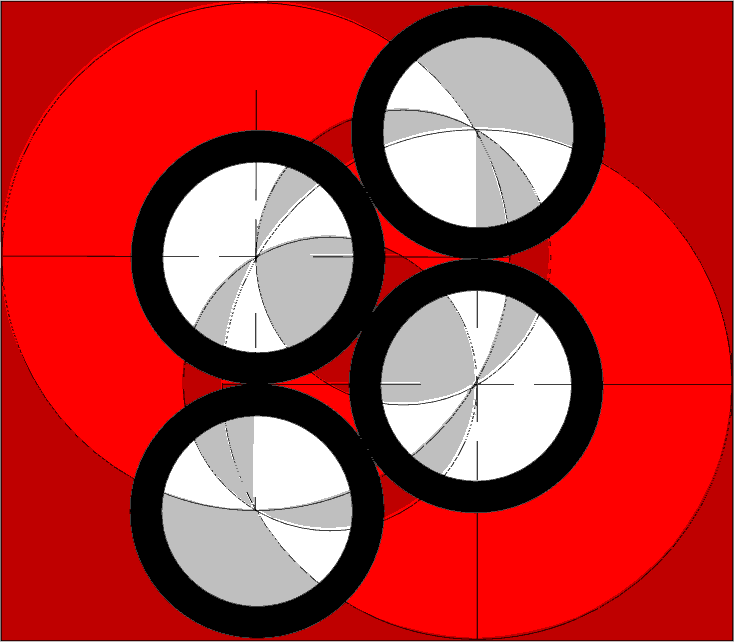Wait for it . . . The circles shown—sometimes partially, because it's artistic!—are drawn by your computer with more or less randomly placed center points (within the space at the right) and more or less random radii. The only mathematical condition is that each pair of circles touches (externally) at exactly one point. [Code]
After the circles are drawn, a dashed line segment is drawn connecting the two circle centers. Does this segment always pass through the point at which the circles touch?
Seems to. Almost seems like it's obvious that this would be true. Nevertheless, there is a proof composed by Euclid, which we'll take a look at below. But you should definitely take a crack at seeing how you would begin this proof—or go about completing it.
Proof By Contradiction Again
Euclid starts with two circles, \(\small\mathtt{ABC}\) and \(\small\mathtt{ADE}\), with "centers" \(\small\mathtt{F}\) and \(\small\mathtt{G}\) as shown below.
I put "centers" in quotes because the placement of these points is fudged a bit, although we're still technically thinking of these as the centers of the two circles. The reason for this is that Euclid supposes the opposite of what he's trying to prove—he imagines that the segment that connects the centers of the circles does NOT pass through the point where the circles touch (point \(\small\mathtt{A}\)).
Instead, he supposes that this segment passes through points \(\small\mathtt{C}\) and \(\small\mathtt{D}\) to connect the two "centers" \(\small\mathtt{F}\) and \(\small\mathtt{G}\). Then he forms a triangle by drawing \(\small\mathtt{\overline{AF}}\) and \(\small\mathtt{\overline{AG}}\).
Now we can do some deducing.
We see that because they are supposedly radii of the same circle, \(\small\mathtt{m\overline{FA}}\) = \(\small\mathtt{m\overline{FC}}\). It would also be true, then, that \(\small\mathtt{m\overline{GA}}\) = \(\small\mathtt{m\overline{GD}}\) in the other circle. And this would mean that \(\small\mathtt{m\overline{FA}}\) + \(\small\mathtt{m\overline{GA}}\) = \(\small\mathtt{m\overline{FC}}\) + \(\small\mathtt{m\overline{GD}}\).
Recall, though, the Triangle Inequality Theorem, which tells us that the shortest distance between two sides in Euclidean geometry is a straight line. So, we know that side \(\small\mathtt{FG}\) must be shorter than \(\small\mathtt{FA}\) + \(\small\mathtt{AG}\). But according to our analysis above, side \(\small\mathtt{FG}\) comes out to be longer than \(\small\mathtt{FA}\) + \(\small\mathtt{AG}\)! Because its length is equal to \(\small\mathtt{FA}\) + \(\small\mathtt{AG}\), plus a little gap between points \(\small\mathtt{C}\) and \(\small\mathtt{D}\).
Since this is a contradiction, the proposition that Euclid was "trying" to prove false is proven true: "If two circles touch one another externally, the straight line joining their centers will pass through the point of contact."

Just Because An "Expert" Said It . . .
. . . doesn't mean that anyone must or should shut off their brains to receive, uncorrupted, the wisdom from the player who currently occupies the stage. As we have already seen with Euclid, there are assumptions and imprecisions in these proofs. I'll leave you with this one from the notes in Book III (Proposition 12), which I am as of yet still wrapping my head around:
Image credit: Miles Gehm